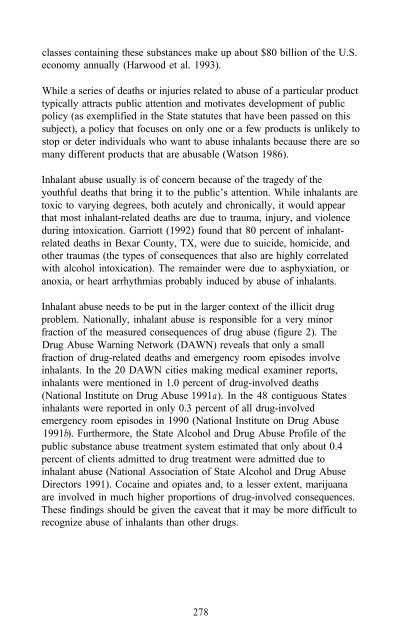Epidemiology of Inhalant Abuse - Archives - National Institute on ...
Epidemiology of Inhalant Abuse - Archives - National Institute on ...
Epidemiology of Inhalant Abuse - Archives - National Institute on ...
Create successful ePaper yourself
Turn your PDF publications into a flip-book with our unique Google optimized e-Paper software.
classes c<strong>on</strong>taining these substances make up about $80 billi<strong>on</strong> <str<strong>on</strong>g>of</str<strong>on</strong>g> the U.S.<br />
ec<strong>on</strong>omy annually (Harwood et al. 1993).<br />
While a series <str<strong>on</strong>g>of</str<strong>on</strong>g> deaths or injuries related to abuse <str<strong>on</strong>g>of</str<strong>on</strong>g> a particular product<br />
typically attracts public attenti<strong>on</strong> and motivates development <str<strong>on</strong>g>of</str<strong>on</strong>g> public<br />
policy (as exemplified in the State statutes that have been passed <strong>on</strong> this<br />
subject), a policy that focuses <strong>on</strong> <strong>on</strong>ly <strong>on</strong>e or a few products is unlikely to<br />
stop or deter individuals who want to abuse inhalants because there are so<br />
many different products that are abusable (Wats<strong>on</strong> 1986).<br />
<str<strong>on</strong>g>Inhalant</str<strong>on</strong>g> abuse usually is <str<strong>on</strong>g>of</str<strong>on</strong>g> c<strong>on</strong>cern because <str<strong>on</strong>g>of</str<strong>on</strong>g> the tragedy <str<strong>on</strong>g>of</str<strong>on</strong>g> the<br />
youthful deaths that bring it to the public’s attenti<strong>on</strong>. While inhalants are<br />
toxic to varying degrees, both acutely and chr<strong>on</strong>ically, it would appear<br />
that most inhalant-related deaths are due to trauma, injury, and violence<br />
during intoxicati<strong>on</strong>. Garriott (1992) found that 80 percent <str<strong>on</strong>g>of</str<strong>on</strong>g> inhalantrelated<br />
deaths in Bexar County, TX, were due to suicide, homicide, and<br />
other traumas (the types <str<strong>on</strong>g>of</str<strong>on</strong>g> c<strong>on</strong>sequences that also are highly correlated<br />
with alcohol intoxicati<strong>on</strong>). The remainder were due to asphyxiati<strong>on</strong>, or<br />
anoxia, or heart arrhythmias probably induced by abuse <str<strong>on</strong>g>of</str<strong>on</strong>g> inhalants.<br />
<str<strong>on</strong>g>Inhalant</str<strong>on</strong>g> abuse needs to be put in the larger c<strong>on</strong>text <str<strong>on</strong>g>of</str<strong>on</strong>g> the illicit drug<br />
problem. <str<strong>on</strong>g>Nati<strong>on</strong>al</str<strong>on</strong>g>ly, inhalant abuse is resp<strong>on</strong>sible for a very minor<br />
fracti<strong>on</strong> <str<strong>on</strong>g>of</str<strong>on</strong>g> the measured c<strong>on</strong>sequences <str<strong>on</strong>g>of</str<strong>on</strong>g> drug abuse (figure 2). The<br />
Drug <str<strong>on</strong>g>Abuse</str<strong>on</strong>g> Warning Network (DAWN) reveals that <strong>on</strong>ly a small<br />
fracti<strong>on</strong> <str<strong>on</strong>g>of</str<strong>on</strong>g> drug-related deaths and emergency room episodes involve<br />
inhalants. In the 20 DAWN cities making medical examiner reports,<br />
inhalants were menti<strong>on</strong>ed in 1.0 percent <str<strong>on</strong>g>of</str<strong>on</strong>g> drug-involved deaths<br />
(<str<strong>on</strong>g>Nati<strong>on</strong>al</str<strong>on</strong>g> <str<strong>on</strong>g>Institute</str<strong>on</strong>g> <strong>on</strong> Drug <str<strong>on</strong>g>Abuse</str<strong>on</strong>g> 1991a). In the 48 c<strong>on</strong>tiguous States<br />
inhalants were reported in <strong>on</strong>ly 0.3 percent <str<strong>on</strong>g>of</str<strong>on</strong>g> all drug-involved<br />
emergency room episodes in 1990 (<str<strong>on</strong>g>Nati<strong>on</strong>al</str<strong>on</strong>g> <str<strong>on</strong>g>Institute</str<strong>on</strong>g> <strong>on</strong> Drug <str<strong>on</strong>g>Abuse</str<strong>on</strong>g><br />
1991 b).<br />
Furthermore, the State Alcohol and Drug <str<strong>on</strong>g>Abuse</str<strong>on</strong>g> Pr<str<strong>on</strong>g>of</str<strong>on</strong>g>ile <str<strong>on</strong>g>of</str<strong>on</strong>g> the<br />
public substance abuse treatment system estimated that <strong>on</strong>ly about 0.4<br />
percent <str<strong>on</strong>g>of</str<strong>on</strong>g> clients admitted to drug treatment were admitted due to<br />
inhalant abuse (<str<strong>on</strong>g>Nati<strong>on</strong>al</str<strong>on</strong>g> Associati<strong>on</strong> <str<strong>on</strong>g>of</str<strong>on</strong>g> State Alcohol and Drug <str<strong>on</strong>g>Abuse</str<strong>on</strong>g><br />
Directors 1991). Cocaine and opiates and, to a lesser extent, marijuana<br />
are involved in much higher proporti<strong>on</strong>s <str<strong>on</strong>g>of</str<strong>on</strong>g> drug-involved c<strong>on</strong>sequences.<br />
These findings should be given the caveat that it may be more difficult to<br />
recognize abuse <str<strong>on</strong>g>of</str<strong>on</strong>g> inhalants than other drugs.<br />
278
















